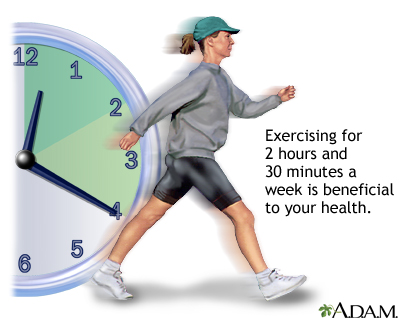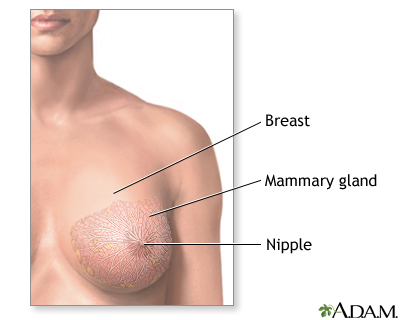Healthy Living
Exercise 60 minutes a day

You get the most benefit from exercise if you do it for at least 60 minutes a day for 5 - 6 days a week. But you do not have to do 60 minutes in a row. Studies suggest that you get the same benefits if you work out for 20 minutes 3 times a day as you do during a longer session.
Exercise with friends

Exercising with a friend or a group of people can help make it more fun, interesting, and keep you motivated to continue with a regular exercise routine.
Exercise - a powerful tool

Physical fitness is essential to good health and is one of the best things you can do for your body, mind, and spirit. Exercise improves the way your body works, and it can make you look better, feel better, and even live longer.
Information
While maintaining good health habits cannot guarantee a longer life, it can certainly improve the quality of your life. A few simple things, if practiced regularly, can help reduce your risk of illness and enrich your life:
- Get regular exercise and control your weight.
- Don't smoke or abuse drugs.
- Do not drink a lot of alcohol. Avoid alcohol completely if you have a history of alcoholism.
- Eat a balanced and healthy diet.
- Take care of your teeth.
- Manage high blood pressure.
- Follow good safety practices.
EXERCISE
Exercise is a key factor in staying healthy. Exercise strengthens the bones, heart, and lungs, tones muscles, improves vitality, relieves depression, and helps you sleep better.
If you are just starting an exercise program and have any pre-existing conditions, such as obesity, hypertension, or diabetes, ask your doctor about an exercise stress test. This test will help you establish safe limits for your exercise program.
Tips for healthy exercise:
- Begin exercising gradually, perhaps with brisk walking. Don't expect to "get into shape" overnight. Your fitness should start to improve within 3 months, provided you maintain a consistent regimen.
- You should work hard enough to sweat during each exercise period, but not so hard that you cannot carry on a conversation.
- Plan an exercise routine that lasts 20 - 30 minutes, and perform the workout at least 3 - 5 days a week. Include stretching before and after your exercise. This will help avoid injury. Remember to start slowly and listen to your body. If it hurts badly, then you are probably overdoing it.
- Aerobic exercises strengthen the heart and lungs and should be part of the fitness routine. Examples of good aerobic exercises include walking, running, jogging, swimming, cross-country skiing, rowing, rope skipping, dancing, racket sports, and cycling. For the biggest benefit, aerobic exercise must be sustained for at least a 10- to 12-minute period.
- Strength and flexibility exercises are important and help you maintain your ability to do daily activites and maintain balance as you grow older.
Adjustments in exercise programs need to be made for children, pregnant women, the elderly, patients who are obese or disabled, and heart-attack survivors. Programs should also be modified for high altitudes and extreme hot or cold conditions.
SMOKING
Cigarette smoking is the single most preventable cause of premature death in the United States, and more than 400,000 Americans die each year from cigarette smoking. One out of every five deaths annually is either directly or indirectly caused by smoking.
Secondhand cigarette smoke exposure causes approximately 3,000 lung cancer deaths in adult nonsmokers in the United States each year. Studies have also linked secondhand smoke with heart disease.
The serious diseases most frequently caused by smoking are:
- Angina
- Chronic bronchitis
- Emphysema
- Heart attack
- Leg pain as a result of blockages in lower extremity arteries (claudication)
- Lung cancer (the risk for smokers is 10 times greater than for nonsmokers)
- Stroke (the risk for smokers is almost 3 times greater than for nonsmokers)
It is never too late to quit smoking. Two years after stopping, your risk of heart attack returns to average and there your lung cancer risk drops by about a third. After 10 years of not smoking, your risk for lung cancer returns to near normal.
ALCOHOL USE
Consumption of alcohol gradually depresses brain function. Emotions, thought processes, and judgment are first to be affected by alcohol consumption. With continued drinking, motor control becomes impaired, causing slurred speech, slower reactions, and poor balance. Both increased body fat and drinking on an empty stomach speed the rate of alcohol intoxication.
The diseases most frequently caused by alcoholism are:
- Acute and chronic pancreatitis
- Bleeding esophageal varices
- Cancer of larynx, esophagus, stomach and pancreas
- Cardiomyopathy
- Cirrhosis of the liver
- Hepatitis
- Impotence
- Mallory-Weiss tear
- Menstrual irregularity
- Sleep disorders
- Wernicke-Korsakoff syndrome
Do not drink alcohol when you are pregnant. Fetal alcohol syndrome is the most common known cause of mental retardation.
Parents should talk to their children about the dangerous effects of alcohol. Establish trusting communication with your children so that sensitive issues can be discussed. Don't allow your children to be guided completely by their peers. Children need firm and loving guidance.
DRUG USE AND ABUSE
Everybody reacts differently to medications. Always tell your doctor about the drugs you are taking, including over-the-counter medications and vitamins.
Drug interactions can have serious health consequences. Elderly people should be particularly careful about drug interactions with multiple medications, and should closely monitor this situation if it applies. Carry a list of your current medications, especially when going to different doctors for the treatment of different problems.
Avoid drinking alcohol while on medications -- this combination can be very dangerous, particularly with tranquilizers or painkillers.
Mothers-to-be should avoid taking any unprescribed drug during pregnancy -- especially during the first trimester, when the fetus is very sensitive to drugs in the mother's body. If you have been taking any drugs just before becoming pregnant, inform your doctor.
Always take medication as prescribed. Taking any drug in a manner other than as intended or in quantities other than directed is considered drug abuse. Abuse and addiction are not just associated with illegal "street" drugs. Legal drugs such as laxatives, painkillers, nasal sprays, diet pills, and cough medicines can also be misused, resulting in serious health problems.
Addiction is defined as compulsive use of a substance despite continued negative consequences. Simply needing a drug (like a painkiller or antidepressant) and taking it as prescribed is not addiction.
The signs and symptoms of addiction are different for each person but may include:
- Agitation
- Bloodshot eyes
- Dazed appearance
- Excessive sweating
- Flushed skin
- Insomnia
- Persistent running nose
- Personality changes
- Unexplained weight loss
- Unpredictable moods
Signs of drug abuse in teenagers may include: apathy, temper tantrums, missing school, sloppy dress, lack of interest in school, excessive demands for privacy, secrecy, and a change in type of friends. However, some teens in trouble may show none of these symptoms.
DEALING WITH STRESS
Stress is normal. It can be a great motivator, and in small amounts can even improve health. However, excessive stress can cause headaches, sleeping problems, stomach problems, mood problems, and more.
Learn to recognize the things most likely to cause stress in your life. You may not be able to avoid all of them, but knowing the source of your stress can help you feel more "in control." The more control you feel you have over your life, the less damaging the stress.
OBESITY
Obesity is serious health concern. It adds stress to the heart, bones, and muscles. and increases the risk for high blood pressure, stroke, varicose veins, breast cancer, and gallbladder disease.
Overeating, an unhealthy diet, and a lack of physical activity can lead to obesity. Your family history also plays a role.
DIET
As a general rule, you should choose foods that are low in saturated and trans fat, and low in cholesterol. Also limit your intake of sugar, salt (sodium), and alcohol. Eat more fiber , which can be found in fruits, vegetables, beans, whole grain products, and nuts.
TOOTH CARE
Good dental hygiene is essential in preserving your teeth for a lifetime. It is important for children to start young with good dental habits. Proper hygiene should include:
- Daily flossing and twice-daily brushing of the teeth
- Use of fluoride toothpaste
- Regular dental checkups
- Limiting sugar intake
- Using a toothbrush with soft bristles (replace the toothbrush with a new one as soon as the bristles become bent)
- Having the dentist instruct you on proper brushing and flossing techniques
- Being aware that "tartar-controlled" toothpastes have little or no effect on tartar below the gum line and, therefore, will not provide a safeguard against gum disease















